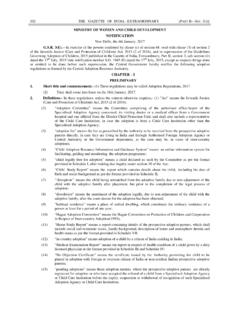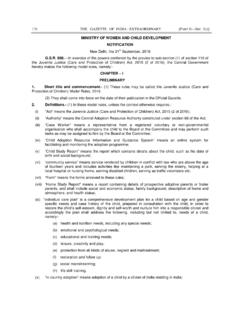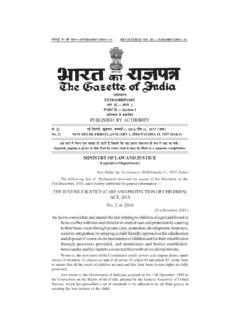Transcription of THE INTEGRATED CHILD PROTECTION SCHEME (ICPS)
1 REVISED INTEGRATED CHILD PROTECTION SCHEME (ICPS). THE INTEGRATED CHILD PROTECTION SCHEME (ICPS). A Centrally Sponsored SCHEME of Government Civil Society Partnership Ministry of Women & CHILD Development Government of India 1. TABLE OF CONTENTS. SECTION NAME CHAPTERS PG. NO. NO. 1. INTRODUCTION 5-7. 2. CONCEPT OBJECTIVES 8. GUIDING 8-9. I INTRODUCTION PRINCIPLES. & CONCEPT. APPROACHES 9-11. TARGET GROUPS 11. CIVIL SOCIETY 11-12. PARTNERSHIP. 3. DISTRICT (DISTRICT CHILD PROTECTION 13-16. UNIT, DCPU). 4. STATE: STATE CHILD PROTECTION 17- 21. SOCIETY (SCPS), STATE ADOPTION. RESOURCE AGENCY (SARA) & STATE. SERVICE PROJECT SUPPORT UNIT (SPSU). II DELIVERY. STRUCTURES 5. CENTRAL LEVEL: CENTRAL PROJECT 22-23.
2 SUPPORT UNIT (CPSU), CENTRAL. ADOPTION RESOURCE AUTHORITY. (CARA) & NATIONAL INSTITUTE FOR. PUBLIC COOPERATION & CHILD . DEVELOPMENT (NIPCCD). IMPLEMENTATI 6. IMPLEMENTATION PLAN & 24-26. ON PLAN, convergence . FUNDING. III PATTERN, 7. FUNDING PATTERN & FUND FLOW 27-29. OUTCOME &. OUTPUT 8. OUTPUT INDICATORS & OUTCOME 30-31. INDICATORS INDICATORS. 9. PROGRAM & ACTIVITIES 32-33. 10. CARE, a) EMERGENCY 34-41. SUPPORT & OUTREACH SERVICES. REHABILITATION. SERVICES. SERVICES. &OTHER b) OPEN SHELTERS 42-45. IV. ACTIVITIES. C) FAMILY BASED 46-55. NON INSTITUTIONAL. CARE THROUGH. SPONSORSHIP, FOSTER CARE, ADOPTION AND. 2. SECTION NAME CHAPTERS PG. NO. NO. AFTERCARE. d) INSTITUTIONAL 56-61.
3 SERVICES. e) GENERAL GRANT 62. IN AID. 11. STATUTORY a) CHILD 63. SUPPORT WELFARE. SERVICES COMMITTEE. b) JUVENILE JUSTICE 64. BOARD. c) SPECIAL JUVENILE 65. POLICE UNITS. i. 12. OTHER 1. HUMAN 66. ACTIVITIES RESOURCE. DEVELOPMENT. 2. TRAINING & 66 67. CAPACITY BUILDING. 3. STRENGTHENING 67 - 68. KNOWLEDGE BASE. 4. CHILD TRACKING 68-69. SYSTEM. 5. ADVOCACY, 70. PUBLIC EDUCATION &. COMMUNICATION. 6. MONITORING 71 - 74. 7. AUDIT 74. 8. EVALUATION 75. V. ANNEXURES I. DISTRICT CHILD PROTECTION UNIT 76-89. (DCPU) & STATE CHILD PROTECTION . SOCIETY (SCPS). II. STATE ADOPTION RESOURCE AGENCY 90-92. (SARA). III. CENTRAL ADOPTION RESOURCE 93-95. AGENCY (CARA). IV. CENTRAL PROJECT SUPPORT UNIT 96-98.
4 (CPSU) & STATE PROJECT SUPPORT UNIT. (SPSU). 3. SECTION NAME CHAPTERS PG. NO. NO. V. convergence 99-102. VI A. MOTHER NGO' PROVIDING 103-107. CHILDLINE SERVICES. VI B FINANCIAL SUPPORT TO REGIONAL 108-111. CENTRES OF THE MOTHER NGO. VII. FINANCIAL SUPPORT TO NODAL, 112-115. COLLABORATIVE, SUPPORT, ORGANISATIONS & DISTRICT SUB- CENTRES OF MOTHER NGO''. VIII. OPEN SHELTERS FOR CHILDREN IN 116-117. NEED FOR URBAN AND SEMI-URBAN. AREAS. IX. FAMILY BASED NON-INSTITUTIONAL 118-119. CARE THROUGH ADOPTION. X. INSTITUTIONAL CARE THROUGH 120-124. VARIOUS KINDS OF HOMES. XI. CHILD WELFARE COMMITTEES (CWC) 125-127. XII. JUVENILE JUSTICE BOARD (JJB) 128-129. XIII. CHILD PROTECTION DIVISION IN 130-134.
5 NATIONAL INSTITUTE OF PUBLIC. COOPERATION AND CHILD DEVELOPMENT. (NIPCCD) & REGIONAL CENTERS. XIV. MINIMUM STANDARDS OF CARE FOR 135-140. INSTITUTIONS ESTABLISHED UNDER. JUVENILE JUSTICE (CARE AND. PROTECTION OF CHILDREN) ACT, 2000 &. UNDER ICPS. 4. SECTION I INTRODUCTION & CONCEPT. 5. CHAPTER 1- INTRODUCTION. 1. CHILD PROTECTION ' is about protecting children from or against any perceived or real danger or risk to their life, their personhood and childhood. It is about reducing their vulnerability to any kind of harm and ensuring that no CHILD falls out of the social safety net and that those who do, receive necessary care, PROTECTION and support so as to bring them back into the safety net.
6 While PROTECTION is a right of every CHILD , some children are more vulnerable than others and need special attention. The Government recognizes these children as children in difficult circumstances', characterised by their specific social, economic and geo-political situations. In addition to providing a safe environment for these children, it is imperative to ensure that all other children also remain protected. This is because CHILD PROTECTION is integrally linked to every other right of the CHILD . 2. Failure to ensure children's right to PROTECTION adversely affects all other rights of the CHILD . Thus, the Millennium Development Goals (MDGs) cannot be achieved unless CHILD PROTECTION is an integral part of programs, strategies and plans for their achievement.
7 Failure to protect children from issues such as violence in schools, CHILD labour, harmful traditional practices, CHILD marriage, CHILD abuse, the absence of parental care and commercial sexual exploitation, amongst others, means failure in fulfilling both the Constitutional and International commitments towards children. 3. The National Charter for Children, 2003 adopted on 9th February 2004, underlined the intent to secure for every CHILD the inherent right to be a CHILD and enjoy a healthy and happy childhood; to address the root causes that negate the healthy growth and development of children; and to awaken the conscience of the community in the wider societal context to protect children from all forms of abuse, while strengthening the family, society and the Nation.
8 4. To affirm Government's commitment towards adopting a rights based approach to address the continuing and emerging challenges in the situation of children, the Government of India drafted the National Policy for Children, 2013, whereby it reiterates its commitment to safeguard, inform, include, support and empower all children within its territory and jurisdiction, both in their individual situation and as a national asset. The State is committed to take affirmative measures legislative, policy or otherwise to promote and safeguard the right of all children to live and grow with equity, dignity, security and freedom, especially those marginalised or disadvantaged; to ensure that all children have equal opportunities; and that no custom, tradition, cultural or religious practice is allowed to violate or restrict or prevent children from enjoying their rights.
9 6. 5. The Ministry of Women and CHILD Development, (MWCD) extends its commitment of the XI plan to create a protective environment for 40 per cent of India's vulnerable children who are experiencing difficult circumstances, by continuing the centrally sponsored SCHEME - the INTEGRATED CHILD PROTECTION SCHEME (ICPS) in the XII. plan. The SCHEME , since its launch in 2009, in partnership with the State Governments/UT Administrations, has strengthened prevention of CHILD rights violation;. enhanced infrastructure for PROTECTION services; provided financial support for implementation of the Juvenile Justice (Care and PROTECTION of Children) Act, 2000;. increased access to a wider range and better quality of PROTECTION services; increased investment in CHILD PROTECTION and is continuously drawing focus on the right of all children to be safe.
10 6. The INTEGRATED CHILD PROTECTION SCHEME (ICPS) has significantly contributed to the realization of Government/State responsibility for creating a system that will efficiently and effectively protect children. Based on the cardinal principles of PROTECTION of CHILD rights and best interest of the CHILD , ICPS is achieving its objectives to contribute to the improvements in the well being of children in difficult circumstances, as well as to the reduction of vulnerabilities to situations and actions that lead to abuse, neglect, exploitation, abandonment and separation of children from their families. 7. CHAPTER 2 - CONCEPT. 1. OBJECTIVES. i) To institutionalize essential services and strengthen structures for emergency outreach, institutional care, family and community based care, counselling and support services at the national, regional, state and district levels.




